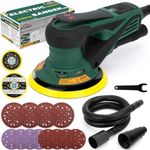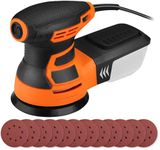We Use CookiesWe use cookies to enhance the security, performance,
functionality and for analytical and promotional activities. By continuing to browse this site you
are agreeing to our privacy policy
Best Palm Sanders
From leading brands and best sellers available on the web.#2
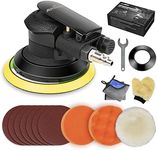
Autolock
Autolock 5 Inches Air Random Orbital Sander, Pneumatic Palm Car Sanders For Wood Polisher Metal,And Auto Body Work, Da Sanders, Dual-action Sander
View Product
#3
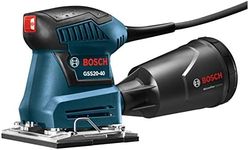
Bosch
6%OFF
BOSCH GSS20-40 Orbital Finishing Sander (1/4-Sheet)
View Product
#4
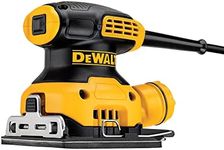
DEWALT
DEWALT Palm Sander, 1/4 Sheet (DWE6411K)
View Product
#5

BLACK+DECKER
BLACK+DECKER Electric Sander, 1/4 Sheet, 1.5-Amp (BDEQS15C)
View Product
Buying Guide for the Best Palm Sanders
Choosing the right palm sander can make your woodworking or DIY projects much easier and more enjoyable. Palm sanders are compact, easy to handle, and perfect for smoothing surfaces or removing old finishes. When picking a palm sander, it's important to consider how you'll use it—whether for small crafts, furniture refinishing, or larger home improvement tasks. Understanding the key features will help you select a sander that matches your needs and ensures comfortable, efficient sanding.Power (Amperage or Voltage)Power in palm sanders is usually measured in amps (for corded models) or volts (for cordless models). This spec tells you how strong the motor is and how well the sander can handle tough jobs. Lower power (around 1.5-2 amps or 12 volts) is suitable for light sanding and small projects, while higher power (2.5 amps or 18 volts and above) is better for more demanding tasks or frequent use. If you plan to use your sander for quick touch-ups or delicate work, a lower-powered model will be lighter and easier to control. For larger surfaces or tougher materials, a higher-powered sander will save you time and effort.
Sanding Pad SizeThe size of the sanding pad determines how much area you can cover at once. Common sizes are around 1/4 or 1/3 of a standard sheet of sandpaper. Smaller pads are great for getting into tight spaces and detailed work, while larger pads cover more area and are better for flat, open surfaces. If you mostly work on small projects or need to sand corners and edges, a smaller pad is ideal. For bigger, flat surfaces like tabletops or doors, a larger pad will help you finish faster.
Speed (OPM - Orbits Per Minute)Speed is measured in orbits per minute (OPM) and shows how fast the sander moves. Some sanders have a single speed, while others offer variable speed settings. Lower speeds (around 10,000 OPM) are gentler and good for fine finishing, while higher speeds (up to 14,000 OPM or more) remove material faster. If you need versatility for different tasks, a variable speed sander lets you adjust the speed to match the job. For simple, everyday sanding, a single-speed model is usually enough.
Dust CollectionDust collection refers to how well the sander captures the dust it creates. Most palm sanders have a built-in dust bag or a port for connecting a vacuum. Good dust collection keeps your workspace cleaner and helps you see your progress. Some systems are more effective than others, so if you work indoors or want to minimize cleanup, look for a sander with a reliable dust collection feature. If you often sand outside or don't mind a bit of mess, this may be less important.
Weight and ErgonomicsThe weight and design of the sander affect how comfortable it is to use, especially for long periods. Lighter sanders are easier to handle and reduce fatigue, making them great for overhead or vertical work. Ergonomic features like soft grips and well-placed controls also make a big difference in comfort. If you have a lot of sanding to do or struggle with hand fatigue, prioritize a lightweight, comfortable model. For occasional use, this may be less critical.
Paper Attachment SystemThis refers to how the sandpaper is attached to the sander. Common systems include clamps, hook-and-loop (like Velcro), or adhesive. Hook-and-loop systems make changing paper quick and easy, which is helpful if you switch grits often. Clamps are more traditional and work with standard sandpaper sheets, but can be slower to change. If you value convenience and speed, look for a hook-and-loop system. If you want to use any sandpaper you have on hand, clamps might be better.
